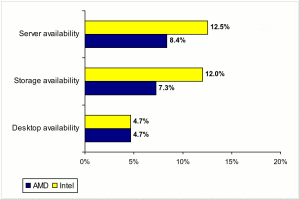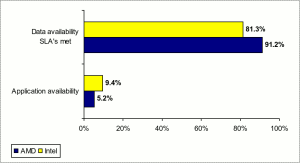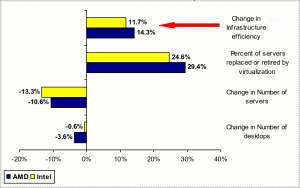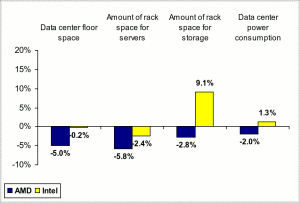
Virtualization has evolved from a development tool running on the desktop to an essential component of IT infrastructure strategy. Companies use virtualization as a means to increase desktop, server and storage utilization, to consolidate data center operations and utility costs, and to reduce the data center’s floor space.
A recently published Aberdeen benchmark, Virtual Strategies: Managing Servers, Desktops and Storage for Infrastructure Efficiency (May 2008), found that 92 percent of companies have implemented some type of server virtualization. AMD and Intel have implemented enhancements to their chipsets that enhance virtual performance for virtual machines, operating systems and applications.
Business Context
Virtualization can address many ills. Optimally, successful virtualization results in a more productive and more flexible data center, which can easily scale to meet new demands. It also results in reduced costs, both in power and data center footprint and increasing data availability — an aggressive set of goals.
End-users of both AMD and Intel virtualization solutions were asked to report their experience in addressing the following virtualization targets:
- System availability
- Data availability
- System complexity
- Impact on space and power requirements
A General Improvement
End-users of both AMD and Intel reported marked improvements in systems availability. As displayed in Figure 1, Intel users’ improvements were about 1.5 times greater for both server and desktop availability. Improvement in storage availability was about equal.
A similar case exists in data/applications availability. General improvements were reported by both sets of users. Intel users reported improvements in data/application availability about 1.8 times greater than that of AMD users. However, as depicted in Figure 2, they also indicated substantially less success in meeting data service level agreements (SLAs). AMD end-users reported meeting these agreements at a rate 12 percent higher than Intel end-users.
System Complexity – Less Is Actually More
All end-users increased the availability of their systems and data to some degree. However, the real benefit is to accomplish enhanced availability while simultaneously reducing the size and complexity of the system configuration. This win-win in performance and efficiency is the holy grail of virtualization, and was met to a substantial degree by end-users of both technologies, as illustrated in Figure 3.
Virtualization has had a significant impact on the size and composition of end-user configurations. Intel end-users turned (by replacement or retirement) almost 25 percent of their server farm and reduced the total number by over 13 percent. AMD end-users turned about 30 percent of their servers, reducing the total number by almost 11 percent.
These numbers depict a virtual tie in this most critical performance metric. However, when asked about change in infrastructure efficiency, a question akin to, “Are you better off today then you were last year?” AMD end-users reported an infrastructure efficiency increase 1.2 times that of Intel.
Less Space + Less Power = More Green
By optimizing existing systems, virtualization can reduce the total number of servers, desktops and storage hardware required to do the same amount of work. The 11 percent to 14 percent efficiency improvements reported above translate into real savings in the footprint size of the system infrastructure requiring support.
In tandem with a reduction in footprint is often a reduction in power requirements. Using less power and less hardware to support similar or greater workloads is a scenario that all “green” advocates would applaud. Figure 4 presents how well end-users of AMD and Intel achieved this status.
AMD end-users reported greater success in both reducing footprint and power consumption. AMD end-users reported footprint reduction in the two areas most specific to x86 virtualization, server rack space and data center floor space, substantially greater than Intel users.
From the “green” perspective, AMD end-users reported a reduction in power consumption while Intel end-users reported a slight gain. In every measure of space utilization and power usage, the performance reported by AMD end-users is slightly and in some cases substantially, better.
Solution Snapshot
Solution providers in virtualizing the x86 platforms are primarily AMD and Intel. Other technologies are utilized to enhance and enable server, desktop and storage virtualization. A partial list of vendors follows:
- Cisco
- Citrix (Xensource)
- HP
- Microsoft
- Red Hat
Key Takeaways
Virtualization can be enabled and enhanced with several technologies. x86 virtualization is effective in addressing multiple issues that plague current system configurations:
- All end-users of AMD and Intel reported substantial improvement in system and application availability.
- The growing problem of system complexity was also addressed with reported reductions in the number of severs required to complete the same or more work and the resulting increase in infrastructure efficiency.
- The reductions in footprint and reductions or containment in power consumption establishes the “green” credentials of this technology and provides users with the opportunity to actually do more with less.
Virtualizing the x86 server farm has major positive ramifications. End-users of both AMD and Intel reported significant progress on several important metrics, so either solution is a better option than non-implementation.
Jeffrey Hill is a senior research analyst in the data management and storage practice group at the Aberdeen Group. He can be reached at [email protected].
Tom Karol is a research associate in the Aberdeen Group’s technology markets area. He can be reached at [email protected].






































